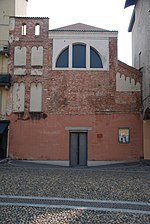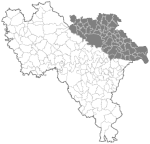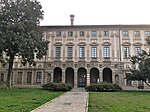Pavia (UK: PAH-vee-ə, US: pə-VEE-ə, Italian: [paˈviːa] , Lombard: [paˈʋiːa]; Latin: Ticinum; Medieval Latin: Papia) is a town and comune of south-western Lombardy, in Northern Italy, 35 kilometres (22 miles) south of Milan on the lower Ticino near its confluence with the Po. It has a population of c. 73,086. The city was the capital of the Ostrogothic Kingdom from 540 to 553, of the Kingdom of the Lombards from 572 to 774, of the Kingdom of Italy from 774 to 1024 and seat of the Visconti court from 1365 to 1413.
Pavia is the capital of the fertile province of Pavia, which is known for a variety of agricultural products, including wine, rice, cereals, and dairy products. Although there are a number of industries located in the suburbs, these tend not to disturb the peaceful atmosphere of the town. It is home to the ancient University of Pavia (founded in 1361 and recognized in 2022 by the Times Higher Education among the top 10 in Italy and among the 300 best in the world), which together with the IUSS (Institute for Advanced Studies of Pavia), Ghislieri College, Borromeo College, Nuovo College, Santa Caterina College, and the Istituto per il Diritto allo Studio (EDiSU), belongs to the Pavia Study System. The 15th-century Policlinico San Matteo is one of the most important hospitals in Italy. Pavia is the episcopal seat of the Roman Catholic Bishop of Pavia. The city possesses many artistic and cultural treasures, including several important churches and museums, such as the well known Certosa di Pavia. The municipality of Pavia is part of the Ticino Valley Natural Park and preserves two forests (Strict nature reserve Bosco Siro Negri and Bosco Grande nature reserve) that they show us the original state of the nature of the Po valley before the arrival of the Romans, before human settlement.











